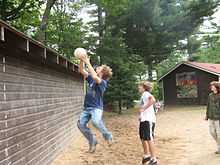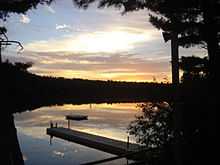Camp Interlaken JCC
Camp Interlaken JCC is a Jewish summer camp located in Eagle River, Wisconsin, USA. The Steve and Shari Sadek Family Camp Interlaken JCC offers a complete residential camping experience for incoming 3rd through 10th grade Jewish children from around the world since 1966. The balanced program gives each camper the opportunity to develop his or her own skills, build self-esteem, and learn Jewish values within a safe, fun, and caring environment. Prior to the purchase by the JCC, it was named Camp Interlaken of the Pines for Boys. According to Jewish Living Magazine, Camp Interlaken is the third best Jewish summer camp in the country.
Camp Interlaken has many specialty staff and a 5:1 camper to staff ratio. Campers sign up for their activities in two week blocks. There are 2, 4, 6 and 8 week sessions available.
Activities



Individual Sports: Tennis, Gymnastics, Golf, Disc golf, Tushball, Ga-ga, Archery, Cycling, Fitness, and Rock Climbing Wall.
Team Sports: Softball, Soccer, Basketball, Volleyball, Floor (Court) Hockey, High/Low Ropes with Zip Line. Ultimate Frisbee and Maccabiah.
Waterfront Activities: Waterskiing, Wake-boarding, Knee-boarding, Windsurfing, Sailing, Small Crafts, Swimming, Life Guard Training
Cultural and Creative activities: Ceramics, Fine Arts, YOGA, Aerobics, Modern Dance, Theater, Theater Tech, Israeli Dance, Bar/Bat Mitzvah Preparation, Woodworking, Crafts, Guitar, Photography, Video, Nature, Fishing and a wonderful Shabbat experience.
Tushball
The main point of Tushball is simple: get the person behind you out while not getting out yourself. Similar to Knockout, you have to be better than the person in front of you. Unlike Knockout, you play it on a long flat roof, with a volleyball. The idea is to throw the ball on the roof. The next person then also has to throw the ball on the roof before it touches the ground. However, they may not touch the ground while touching the ball, like Tips. Tushball was first played in the early 1960s at Camp Timberlane,[1] but with the ball being tapped like a volleyball instead of caught and thrown, and players don't have to leave the ground.
Additional Rules
- The first player in line throws the ball on the roof. It must bounce 3 times or roll at least briefly. If it does not bounce 3 times, roll, or if it goes over the top or side of the roof, the server may reserve 1 time. A second failed serve results in the server being out and the ball goes to the next player in line.
- If the next player fails to return a ball, that player is out. The next player in line after the out player then serves the ball.
- Once you have served or returned, you go to the back of the line
- All additional throws only need bounce once, however they must bounce while coming down on the roof, and may not be spiked or slammed downward
- The ball may be thrown or tapped or have any movement (except spikes or slams) as long as the player is still in the air. The thrower may not pull the ball downward. All throws need to have either a neutral or upward direction on the vertical axis.
- A ball must exit the roof over the lower edge of the roof. If it falls off the side or over a vertical out of bounds line on the roof, the thrower is out.
- If the next player in line is obstructed from getting to the ball due to another player, obstruction is called, and the player in line before the obstructed player then serves the ball to the obstructed player.
Famous Shots
- The Nanner: The ball is thrown high in the air, either overhand or underhand, often with a planned second bounce near the edge of the roof, making it difficult for the next player to judge the path of the ball. Beloved by all for its effectiveness and ability to be played by low and high skill level players. If the ball goes over the top of the roof, the thrower is out.
- The Side Shot: The ball is thrown in a largely horizontal path across the roof.
- The Stall: The ball is placed gently just on the edge of the roof.
- The Reverse Side: The ball is placed on the roof with the hand still on it. The ball is pushed to one side, then the direction is reversed. Highly skilled players can do multiple reversals of direction. The shot may also start with a Stall.
Notable attendees
Former Hall of Fame NFL football coach Marv Levy spent several summers in the 50's working at Camp Interlaken when it was run by Joe Kupcinet, before it was owned by the JCC.[2]
References
- ↑ Marks, John (August 6, 1976). "Tushball: Up and Coming Sport". Timberlife Magazine 2 (2).
- ↑ Marv Levy: Where Else Would You Rather Be?, Sports Publishing, 2004. ISBN 1-58261-797-X
External links
| ||||||||||
Coordinates: 45°53′56″N 89°24′06″W / 45.898872°N 89.401621°W